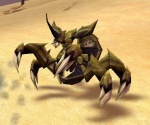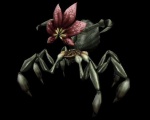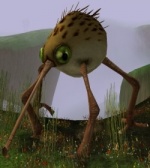La Faune, associée à la Flore, les races intelligentes, contribue à créer un écosystème vraiment authentique et réactif où l'équilibre de la nature se développe continuellement en accord avec les actions des homins. Voici une liste des créatures que vous pouvez rencontrer sur Atys. Vous trouverez au bas de la page une liste sans images ou decription des créatures.
Voir aussi
| Nom | Type | Description | |
|---|---|---|---|

|
Arana | Herbivore | The arana is a master of disguise. Its body and its two pairs of jointed limbs evolved to resemble a tree stump to the extent of growing tufts of hair resembling grass and harboring mushrooms and moss on its back. Its carapace and legs are protected by sharp spine-like excrescences to deter predators. It has small eyes on fleshy stems sprouting from the top of the head, and powerful lower tusk-like mandibles with which it will attack if threatened. |

|
Arma | Herbivore | A massive pachyderm characterized by a mossy carapace equipped with spiny outgrowths. Its thick skin and impressive array of defensive horns on its head make it a difficult prey for even the keenest carnivore. |

|
Bawaab | Herbivore | Of the same family as the lumper, the bawaab is characterized by its green scaly skin and a flat 'hammer head' with an eye at each extremity. The bawaab has pillar-like legs, large feet and moves at a surprisingly fair speed. |

|
Bodoc | Herbivore | A bulky, thick-skinned plant feeder with tiny eyes and two massive horns protruding from the sides of the head. |

|
Bolobi | Herbivore | This spherical quadruped has large bulbous protruding eyes set wide apart giving it a field of vision of 270°. Its neckless head is sunk into its body which is covered in a deep fur coat making it resemble a ball of fluff! Using its powerful trunk, the bolobi can be seen drawing up berries, nuts and sap, which it ferments in its belly to produce a lethal gas. |

|
Capryni | Herbivore | A deer-like ruminant with a goatee beard distinguished by its thick skin laid on like rhinoceros hide. A shy creature, its tough single antler is used more to attract a mate than to fend off predators, though will deliver a formidable hind kick when menaced. |

|
Clopper | Crustacean | This brownish crustacean feeds on carrion and sometimes mortally wounded animals. The clopper gets its name from the sound it makes with its well developed pincers on approaching its wounded prey. |

|
Cray | Crustacean | This brightly colored crustacean has four identical powerful limbs, a set of feelers situated about its mouth, and eyes set on stalks giving it an all round vision. |

|
Cuttler | Carnivore | This grim looking hunter has a spiny back with blade-like horns running down the length of its spine and spurs on its tibias. Its long tapering hooves allow it to dig into the ground to gain a good grip to break into a very rapid sprint at any moment. |

|
Frippo | Omnivore | This small common omnivore, liken to the yubo in size, has powerful front legs supporting a vigorous body, heavy head with a powerful muzzle. Its thick hide has allowed it to evolve into a tenacious and daring creature despite its relative slowness. |

|
Gingo | Carnivore | A frenetic canine-like animal with a mane and strong shoulders that are higher than its hind quarters, powerful jaws and strong teeth. Gingos live in pacts of up to five individuals and feed on carrion left over by predators. |

|
Gnoof | Herbivore | The gnoof is a gregarious herbivore characterized by a trunk which it uses to collect food, bring water to the mouth, for smelling, and for lifting. |

|
Goari | Crustacean | A crustacean with four identical legs, two powerful pinchers, and characterized by a translucent sphere containing a watery substance which it dangles above its head. |

|
Gubani | Herbivore | This timorous and gregarious herbivore has long powerful hind legs and gripping feet perfectly adapted for rapid movement. Its two 'winglets' on the crest of its back dote it with extra streamline allowing it to run very swiftly in leaps and bounds over difficult terrain. |

|
Horncher | Crustacean | A crustacean with four identical legs, a pair of powerful pincers and stylelike appendages at the end of the abdomen. The horncher gets its name from the horn shell which its carapace resembles. |

|
Igara | Oiseaux | Oiseau de proie doté d'un bec pointu et rapace ainsi que de quatre ailes d'une envergure de plus de 3 mètres, l'igara se distingue par sa queue barbelée et mortelle qu'il utilise quand il attaque. Il serre les troncs d'arbres avec ses griffes et ses ailettes arrières enduites de sève. Quand il aperçoit une proie, il pique droit dessus. |

|
Izam | Oiseaux | L'Izam, paradoxalement, est un sombre opportuniste qui n'attaque que des proies plus faibles que lui. Charognard ailé dont le plumage tacheté lui permet de se fondre dans le feuillage, l'Izam plane dans les hauteurs, attendant patiemment son heure tout en scrutant les sous-bois, puis pique sur une proie plus faible, annonçant son arrivée par un cri moqueur et strident (qui évoque la mouette d'origine terrienne).
Sa peau lumineuse et tachée assure son camouflage parmi le feuillage du ciel d'Atys. Il étend ses longues ailes et plonge sur sa proie pour la tuer. Sa peau et ses dents sont des ressources utiles. |

|
Javing | Oiseaux | Oiseau de proie aux ailes dentelées et au vol agité, le javing n'a pas d'yeux et chasse sa nourriture en partie à l'aide de son odorat et surtout à l'aide de son système d'écholocation. Il produit des vagues de sons aigus qui renvoient l'écho des obstacles et permettent ainsi à l'oiseau de se diriger avec précision. Le javing est muni d'une longue langue noire, luisante et barbelée qu'il utilise pour transpercer sa proie. |

|
Jugula | Carnivore | A disarming squat predator with protruding eyes and powerful hind legs for leaping. The skin on its back contains short, sharp, stocky-based spines which help deter larger predators. |

|
Kiban | Récolteur | Grand arachnide omnivore et principalement blanc, le Kiban est doté d'un gros abdomen. Ce récolteur kitin collecte des ressources pour la colonie. |

|
Kidinak | Soldat royal | Ce drone kitin s'accouple avec la reine et la protège. Sans trop s'éloigner de la reine, le kidinak attaquera les prédateurs à vue en projetant ses appendices en forme de houe pour entailler l'agresseur. Les pattes avant du kidinak sont modifiées de façon à former de petites tenailles lui permettant de couper et de porter la nourriture à sa bouche. |

|
Kincher | Éclaireur | Le Kincher est connu comme étant l'éclaireur kitin, car il précède toujours d'autres kitins dans un territoire inconnu et a la capacité étrange de définir l'emplacement exact de matières premières précieuses. Il mange et analyse tout sur son chemin, choisissant et marquant les meilleures matières premières pour ses cousins. Le Kincher attaquera tout ce qui approchera de ses provisions préférées. Ses tentacules, carapace chitineuse et excroissances épineuses sont bonnes à prendre.
Ce chasseur Kitin est reconnaissable à ses énormes mandibules, à son petit abdomen et à son excroissance dorsale. |

|
Kinrey | Soldat royal | Ce soldat royal kitin est l'un des prédateurs les plus virulents d'Atys. C'est un géant grégaire vivant en communauté et protégeant la reine. Le kinrey asperge d'acide ses victimes, attaque et poursuit les homins ou les bêtes qui s'aventurent trop près du nid. |

|
Kipee | Ouvrier | Ce placide Kitin, un géant terrestre, vit en troupeau et ronge l'écorce des arbres d'Atys toute la journée. Les pucetrons seuls portent la marque de leur troupeau sur leur flancs chitineux. Les autres Kitins traient le Kipee pour le suc riche qu'il produit, et les Homins les chassent pour leur carapace flexible et leur chair, malgré leur morsure douloureuse.
Cet ouvrier Kitin est le seul véritable herbivore de la famille des Kitins. Ce grand arachnide paisible construit des nids et s'occupe des larves. On le voit souvent en groupe, passant toute la journée à dévorer des écorces à belles dents. |

|
Kipesta | Éclaireur | Eclaireur kitin très coloré, doté de six ailes et d'un abdomen allongé, le Kipesta recherche de nouveaux territoires pour les migrateurs, afin d'installer d'autres nids. Il projette une puissante substance de pollen enflammé sur sa proie. Son venin est stocké et produit dans une poche qui se dégonfle à mesure que la substance s'écoule par sa trompe et s'enflamme au contact de l'air. |

|
Kipucka | Ouvrier | Dangereux et hideux cousin du Kirosta, le Kipucka est une créature crasseuse issue des entrailles d'Atys et qui mange tout sur son chemin. Ouvrier migrateur qui crée de nouveaux nids, son gros abdomen lui permet de transporter des ressources et des larves vers un nouveau territoire. Au bout de sa queue, le Kipucka est doté d'un aiguillon mortel qu'il utilise pour tuer lors d'une attaque. Les chrysalides voraces qui réchappent à l'impact dévorent leur victime vivante en quelques secondes. Effrayant. |

|
Kipucker | Soldat | Un kitin qui ressemble au kipucka, il peut être vu durant les invasions. |

|
Kirosta | Soldat | Cet énorme soldat kitin reconnaissable à son long abdomen fuselé terrorise toute la faune vivant dans son entourage. Il injecte son venin, un des plus virulents sur Atys, dans sa proie grâce à l'épine qui se trouve à l'extrémité de son abdomen. |

|
Kizarak | Royal | Le Kizarak est aussi beau qu'il est mortel. Ne pensez même pas jeter un coup d'oeil à ses pétales de plus près, cette effrayante beauté arachnide projette une soie gluante en direction de ses victimes pour les immobiliser, et les observe ensuite lutter tandis qu'il se régale d'avance du plat à venir. |

|
Kizoar | Récolteur | Le Kizoar est un charognard prudent qui fuit au moindre danger grâce à de puissantes ailes, d'une envergure de 2 mètres, qui lui permettent de fuir rapidement. Il récolte des ressources pour la colonie. Il plane au-dessus d'une proie agonisante jusqu'à ce qu'il soit suffisamment hors de danger pour l'achever avec son dard mortel. On peut trouver cet ouvrier kitin partout sur Atys.
Cette sale créature empoisonnante est devenue une des sources principales de matériau kitin, malgré la rancune... Aucun homin n'aime entendre bourdonner un Kizoar. |

|
Lumper | Herbivore | A timorous herbivore that feeds mainly on cacti. The lumper has long legs allowing it to move at a surprisingly fair speed. It has large eyes set apart on fleshy stems sprouting from either side of the head and is especially characterized by its spiny back. |

|
Madakam | Omnivore | Like the ploderos, the slow-moving madakam is a solid lump of a creature able to nonchalantly amble around grazing fearless of potential predators thanks to its massive horny head and thick hide. Its triangular head is armed with an impressive machete-like horn which the madakam will use to lethal effect if menaced. |

|
Mektoub | Herbivore | A placid plant feeding pachyderm easily recognized by its long and powerful trunk which it uses to collect food, convey water to the mouth, for smelling, and for lifting. Like the gnoof, it has dexterous feet with large bulbous toes enabling it to radiate heat. |

|
Messab | Herbivore | A shy, hoofed animal with a slender head, a long neck, a hump and long legs. The messab's partial blindness is compensated by its echo-location facility allowing it to navigate in the most difficult terrain littered with obstacles. |

|
Najab | Carnivore | A large carnivorous amphibian with slimy skin. When threatened by other predators it will spit fermented algae at the aggressor and hop into the water to swim to safety. |

|
Ocyx | Carnivore | The ocyx is immediately distinguishable by its exoskeleton which forms an impressive body defense. This predator is equipped with a powerful mussel characterized by two sharp canine teeth protruding from the lower mandible, and long claws. |

|
Ploderos | Herbivore | A massive stocky pachyderm with small eyes and ears, thick and heavy body and stubby legs. The ploderos grazes all day long plodding steadily from one pasture ground to the next seemingly oblivious to the dangers around. Its thick red hairless hide and the hard horny protective cover of its head presents a formidable defense against preying carnivores. |

|
Ragus | Omnivore | A canine-like creature with retractable claws, rasping tongue and five eyes which allow it to see in all kinds of light. |

|
Raspal | Herbivore | The raspal is a hoofed mammal belonging to the same order as the capryni. It has a slender head, long neck and two winglets situated on the crest enhancing its stability and allowing it to work up to a fast gallop even over uneven terrain. |

|
Rendor | Herbivore | A stocky hoofed mammal with a short thick neck and belonging to the same family as the capryni. It has a heavy front body and a hump on its back. Its large head is covered with a helmet-like leather carapace which constitutes a formidable ram for defense. |

|
Shalah | Herbivore | A ruminant distinguished by a heavy shaggy coat and long tusks that sprout either side from its lower mandible. The tusks and the thick leather plates layered on its face constitute a tough defense. |

|
Timari | Herbivore | A herbivorous creature with bandy legs and huge one meter high dorsal spines which act as a formidable defense in case of attack. |

|
Torbak | Carnivore | An Atysian feline par excellence distinguished by its long saber-like horn, three dorsal spines and a pointed bony tail. |

|
Tyrancha | Carnivore | A terrifying carnivore, the Tyrancha has two pairs of identical legs attached to an elongated, larva-like body culminating in a large round orifice with irregular lacerating teeth. |

|
Varinx | Carnivore | A carnivorous desert feline with a fire resistant hide capable of blending into the desert hues and the shadows of the Prime Roots. The varinx prowls in groups of 2 or 3 around fire holes in the Burning Desert where it will save homins from fire and then eat them alive. |

|
Vorax | Carnivore | A three and a half meter long lizard-like predator with a spiny back, terrifying red eyes and razor-sharp teeth. A fast, cunning and ferocious hunter which can immobilize its prey with a terrifying roar. |

|
Wombaï | Herbivore | Of the same family as the bolobi, the wombaï is doted with large eyes for an all round vision and a long proboscis which it uses to draw up seeds, insects and nuts from both ground and bush. The wombaï, with its trunk and its round neckless head protruding from its spherical body, resembles a hairy pear on legs! |

|
Yber | Oiseaux | Oiseau de deux mètres de hauteur, d'une envergure allant jusqu'à quatre mètres, l'yber est un cousin gracieux de l'Izam. Il vole très vite en frôlant le sol à la recherche d'une proie plus petite. Il se caractérise par son bec puissant et ses deux paires d'ailes diaphanes supplémentaires qui sécrètent une substance visqueuse lui permettant de capturer des insectes et des petits oiseaux. Les Ybers sont les premières créatures dans la mémoire vivante d'Atys. Ils ont volé sur l'Écorce longtemps avant que le premier homin ait jamais respiré. Créatures étranges et surprenantes avec leur vision à 180 degrés et des yeux extrêmement larges, les Ybers sont des êtres généralement paisibles, mais ils tueront si vous arrivez sous leur peau. |

|
Yelk | Omnivore | A great sluggish lump of a scavenger easily recognized by its pointed snout and the highly prized mushrooms growing on its back. These poisonous mushrooms act as a formidable deterrent to any hungry predator. |

|
Yetin | Omnivore | The yetin is a hoofed omnivore with powerful hind legs for very rapid movement, a well developed thorax and a large heavy head. Its violet body is tinged with a ruddy coat of coarse bristly hairs. |

|
Yubo | Omnivore | A small, fairly slow moving dog-like omnivore originally bred by Matis manipulators to provide company and entertainment to homins, as well as a source of nourishment. |

|
Zerx | Omnivore | A omnivorous creature feeding especially on berries and nuts which it stores in its pouch-like gullet. Has a small round tail, stiff hairs on its back, and eyes set at 180° apart on fleshy stems sprouting from the sides of its head. The zerx will spit out fruit, pips and acid, and uses its tusks to get the better of any rival. |
Sous-catégories
Cette catégorie comprend 15 sous-catégories, dont les 15 ci-dessous.
B
E
F
H
I
K
M
N
P
Q
Pages dans la catégorie « Faune »
Cette catégorie comprend 96 pages, dont les 96 ci-dessous.